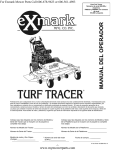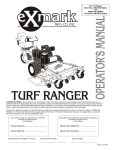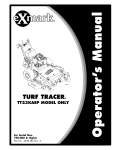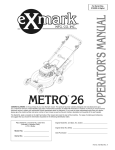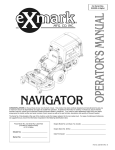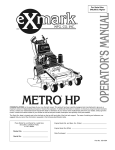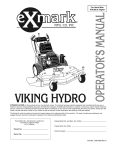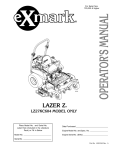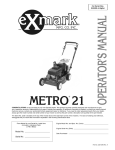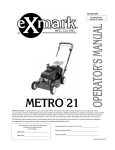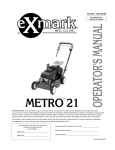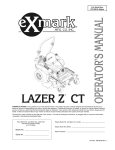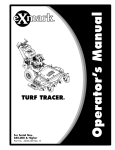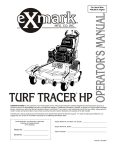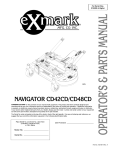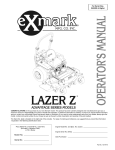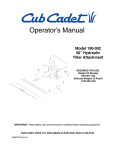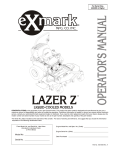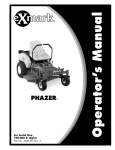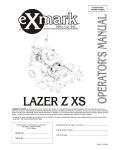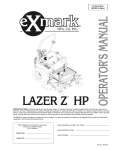Download Exmark FMD524 User's Manual
Transcript
For Turf Tracer Serial Nos. 510,000 & Higher and FMD524 & FMD604 Serial Nos. 510,000 & Higher Part No. 103-9190 WARNING POTENTIAL HAZARD ♦ This product is a piece of power equipment. WHAT CAN HAPPEN ♦ Failure to follow safe operating practices can result in serious operator injury or even death. HOW TO AVOID THE HAZARD ♦ Keep all shields, guards, and safety devices (especially the grass discharge system) in place and in proper working condition. ♦ Stop engine and wait for all moving parts to stop. Remove spark plug wire(s) or remove key before adjusting, servicing, or performing maintenance. ♦ If mower deck becomes clogged, stop engine and wait for all moving parts to stop. Remove spark plug wire(s) or remove key before cleaning blockage. ♦ Keep hands, feet, and clothing away from power driven parts. ♦ Keep off mower unless seat platform is provided. ♦ Keep others off mower. WARNING POTENTIAL HAZARD ♦ Gasoline is harmful or fatal if swallowed. Long-term exposure to vapors has caused cancer in laboratory animals. WHAT CAN HAPPEN ♦ Failure to use caution may cause serious injury or illness. HOW TO AVOID THE HAZARD ♦ Avoid prolonged breathing of vapors. ♦ Keep face away from nozzle and gas tank/container opening. ♦ Keep away from eyes and skin. ♦ Never siphon by mouth. IMPORTANT When the mower is used or operated on any California forest, brush or grass covered land, a working spark arrester must be attached to the muffler. If not, the operator is violating state law, Section 4442 Public Resource Code. To acquire a spark arrester for your unit, see your Engine Service Dealer. This spark ignition system complies with Canadian ICES-002 Ce système d’allumage par ètincelle de vèhicule est conforme à la norme NMB-002 du Canada The enclosed Engine Owner’s Manual is supplied for information regarding The U.S. Environmental Protection Agency (EPA) and the California Emission Control Regulation of emission systems, maintenance and warranty. Keep this engine Owner’s Manual with your unit. Should this engine Owner’s Manual become damaged or illegible, replace immediately. Replacements may be ordered through the engine manufacturer. Exmark reserves the right to make changes or add improvements to its products at any time without incurring any obligation to make such changes to products manufactured previously. Exmark, or its distributors and dealers, accept no responsibility for variations which may be evident in the actual specifications of its products and the statements and descriptions contained in this publication. EXMARK PARTS PLUS® PROGRAM EFFECTIVE DATE: September 1, 1995 Program If your Exmark dealer does not have the Exmark part in stock, Exmark will get the parts to the dealer the next business day or the part will be FREE* Guaranteed!! How the Program Works 1. If dealer does not have part in stock for a "down" unit at the time of request by customer, the dealer contacts his distributor by 1:00 p.m., local time, and requests Exmark Parts Plus® shipment of six (6) line items or less. 2. Distributor ships part(s) to dealer or customer, as requested by dealer, same day, overnight UPS Distributor bills dealer for part and freight charges where applicable. 3. If distributor does not have the part(s) in stock to satisfy Exmark Parts Plus® order, he contacts Exmark by 3:00 p.m., central time, with an Exmark Parts Plus® order of six (6) line items or less. 4. If order is received by 3:00 p.m. central time, Exmark ships part(s) direct to dealer or customer, as requested by distributor, same day, overnight UPS Exmark bills the distributor for parts and shipping charges, where applicable. 5. The customer pays for the part and freight if it is shipped under the Exmark Parts Plus® and if it arrives in accordance to the program. 6. Who pays for the part and freight if it fails to arrive overnight in accordance to the program? A. Under any circumstance the customer does not pay. B. If the part does not arrive overnight due to: 1. The dealer not submitting the Exmark Parts Plus® order to his Exmark distributor by 1:00 p.m., the dealer pays for the part and freight. 2. The Distributor being unable to ship the part the same day or not submitting the Exmark Parts Plus® order to Exmark by 3:00 p.m., central time, the Distributor pays for the part and freight. 3. Exmark being unable to ship the part and the Exmark parts order is received by 3:00 p.m., central time, Exmark pays for the part and freight. 4. If the part does not arrive overnight due to the shipper (UPS), the shipper pays for the freight and Exmark pays for the part. The following restrictions apply -- The Exmark Parts Plus® Program is available only through participating Exmark Dealers and applies only to orders submitted on this program Monday through Thursday. Parts Plus service is only available in the 48 contiguous United States. UPS has initiated a Saturday delivery program to many areas of the continental United States and can be requested for an overnight shipment on Friday to be delivered Saturday. The next day air charge, plus the Saturday delivery fee will be the responsibility of the purchaser. Exmark Mfg. will assume no responsibility for Saturday delivery shipments. To qualify, all Exmark Parts Plus® orders must be received by Exmark by 3:00 p.m., central time. Orders must be six (6) line items or less. Exclusions from the Exmark Parts Plus® Program are: Any wholegood or accessory in its entirety, engines and engine replacement parts, 5-speed Peerless transmissions and 5-speed transaxles, hydraulic or hydrostatic wheel motors, cutter decks and engine decks or any item exceeding United Parcel Service size and weight restrictions. Due to UPS restrictions, aerosol spray paint is considered a hazardous material and cannot be shipped via UPS next day or Second Day Air. Exmark Manufacturing stocks a limited supply of parts for transaxles, pumps and wheel motors. These parts can be ordered for Next Day Air shipment but will not be guaranteed per the Parts Plus Program. -i- CONGRATULATIONS on the purchase of your Exmark Mower. This product has been carefully designed and manufactured to give you a maximum amount of dependability and years of trouble-free operation. OPERATOR'S MANUAL This manual contains assembly, operating, maintenance, adjustment, and safety instructions for your Exmark mower. BEFORE OPERATING YOUR MOWER, CAREFULLY READ THIS MANUAL IN ITS ENTIRETY. By following the operating, maintenance, and safety instructions, you will prolong the life of your mower, maintain its maximum efficiency, and promote safe operation. If additional information is needed, or should you require trained mechanic service, contact your authorized Exmark equipment dealer or distributor. All Exmark equipment dealers and distributors are kept informed of the latest methods of servicing and are equipped to provide prompt and efficient service in the field or at their service stations. They carry ample stock of service parts or can secure them promptly for you from the factory. All Exmark parts are thoroughly tested and inspected before leaving the factory, however, attention is required on your part if you are to obtain the fullest measure of satisfaction and performance. - ii - TABLE OF CONTENTS 1. SAFETY .............................................................................................PAGE 1.1 1.2 1.3 1.4 1.5 1.6 1.7 Safety Alert Symbol...................................................................................... 1 Training ........................................................................................................ 1 Preparation................................................................................................ 1-3 Operation .................................................................................................. 4-6 Maintenance & Storage ............................................................................. 6-7 Riding Attachments ...................................................................................... 7 Safety Signs ........................................................................................ ..... 7-9 2. SPECIFICATIONS 2.1 Model Number............................................................................................ 10 2.2 Engine........................................................................................................ 10 2.3 Fuel System ............................................................................................... 10 2.4 Electrical System........................................................................................ 10 2.5 Steering/Brake Control ............................................................................... 10 2.6 Transmission.............................................................................................. 10 2.7 Wheel Drive System................................................................................... 10 2.8 Tires ........................................................................................................... 11 2.9 Deck........................................................................................................... 11 2.10 Dimensions ............................................................................................... 11 2.11 Torque Requirements................................................................................ 11 3. ASSEMBLY INSTRUCTIONS 3.1 to 3.12 Assembly................................................................................... 12-15 4. OPERATION INSTRUCTIONS 4.1 4.2 4.3 4.4 Controls................................................................................................. 15-17 Pre-Start..................................................................................................... 17 Operation Instructions ........................................................................... 17-19 Transporting ............................................................................................... 20 5. MAINTENANCE & ADJUSTMENTS 5.1 Periodic Maintenance ............................................................................ 20-29 5.2 Adjustments .......................................................................................... 30-35 6. WASTE DISPOSAL 6.1 Motor Oil Disposal ...................................................................................... 35 6.2 Battery Disposal ......................................................................................... 35 7. TROUBLE SHOOTING 7.1 Mower Tracks Left or Right ........................................................................ 35 7.2 Mower Cuts Unevenly ................................................................................ 36 7.3 Engine Will Not Start ............................................................................. 36-37 8. HYDRAULIC SCHEMATIC ........................................................................... 38 9. WIRING DIAGRAM ....................................................................................... 39 10. WARRANTY ................................................................................................. 40 - iii - 1. SAFETY 1.1 SAFETY ALERT SYMBOL This SAFETY ALERT SYMBOL is used both in this manual and on the machine to identify important safety messages which must be followed to avoid accidents. This symbol means: ATTENTION! BECOME ALERT! YOUR SAFETY IS INVOLVED! The safety alert symbol appears above information which alerts you to unsafe actions or situations and will be followed by the word DANGER, WARNING, or CAUTION. DANGER: White lettering / Red background. Indicates an imminently hazardous situation which, if not avoided, WILL result in death or serious injury. WARNING: Black lettering / Orange background. Indicates a potentially hazardous situation which, if not avoided, COULD result in death or serious injury. CAUTION: Black lettering / Yellow background. Indicates a potentially hazardous situation which, if not avoided, MAY result in minor or moderate injury. 1.2 TRAINING 1.2.1 Regard the Exmark mower as a piece of power equipment and teach this regard to all who operate this unit. 1.2.2 Read the instructions carefully. Familiarize yourself with the controls and the proper use of the equipment. If the operator(s) or mechanic(s) can not read English, it is the owner’s responsibility to explain this material to them. 1.2.3 Do not allow operation of this machine by untrained personnel. Never allow children, teenagers, or people unfamiliar with these instructions to use the mower. Local regulations may restrict the age of the operator. 1.2.4 Avoid mowing while people, especially children, or pets, are nearby. Keep in mind that the operator or user is responsible for accidents or hazards occurring to other people or their property. 1.3 PREPARATION 1.3.1 Evaluate the terrain to determine what accessories and attachments are needed to properly and safely perform the job. Only use accessories and attachments approved by Exmark. 1.3.2 The use of personal protective equipment, such as (but not limited to) protection for the eyes, ears, feet, and head is recommended. CAUTION POTENTIAL HAZARD ♦ This machine produces sound levels in excess of 85 dBA at the operator’s ear when in operation. WHAT CAN HAPPEN ♦ Exposure to sound levels of 85 dBA or above for extended periods of time can cause hearing loss. HOW TO AVOID THE HAZARD ♦ Wear hearing protection when operating this machine. 1.3.3 While mowing, always wear substantial footwear and long trousers. Do not operate equipment when barefoot or when wearing open sandals. -1- 1.3.4 Thoroughly inspect the area where the equipment is to be used and remove all stones, sticks, wires, bones, and other foreign objects which may damage the equipment or cause personal injury to the operator or bystanders. WARNING POTENTIAL HAZARD ♦ Engine exhaust contains carbon monoxide, which is an odorless deadly poison. WHAT CAN HAPPEN ♦ Carbon monoxide can kill you. HOW TO AVOID THE HAZARD ♦ Do not run engine indoors or in a small confined area where dangerous carbon monoxide fumes can collect. DANGER POTENTIAL HAZARD ♦ In certain conditions gasoline is extremely flammable and highly explosive. WHAT CAN HAPPEN ♦ A fire or explosion from gasoline can burn you, others, and cause property damage. HOW TO AVOID THE HAZARD ♦ DO NOT smoke while refueling, and stay away from an open flame or where gasoline fumes may be ignited by spark. ♦ Refuel only outdoors. ♦ Store gasoline in an approved container and keep it out of the reach of children. ♦ Add fuel before starting the engine. Never remove the cap of the fuel tank or add fuel when engine is running or when the engine is hot. ♦ Never fill the fuel tank so that the gasoline level rises above a level that is 1/2” below the bottom of the filler neck to allow for gasoline expansion and prevent fuel spillage. ♦ If fuel is spilled, DO NOT attempt to start the engine. Move away from the area of the spill and avoid creating any source of ignition until fuel vapors have dissipated. ♦ Do not operate without entire exhaust system in place and in proper working condition. -2- DANGER POTENTIAL HAZARD ♦ In certain conditions gasoline is extremely flammable and highly explosive. WHAT CAN HAPPEN ♦ A static charge can ignite gasoline vapors. A fire or explosion from gasoline can burn you, others, and cause property damage. HOW TO AVOID THE HAZARD ♦ Purchase and store gasoline only in an approved container. ♦ Always place gasoline containers on the ground away from your vehicle before filling. ♦ Do not fill gasoline containers inside a vehicle or on a truck or trailer bed because interior carpets or plastic truck bed liners may insulate the container and slow the loss of any static charge. ♦ When practical, remove gas-powered equipment from the truck or trailer and refuel the equipment with its wheels on the ground. ♦ If this is not possible, then refuel such equipment on a truck or trailer from a portable container, rather than from a gasoline dispenser nozzle. ♦ If a gasoline dispenser nozzle must be used, keep the nozzle in contact with the rim of the fuel tank or container opening at all times until fueling is complete. WARNING POTENTIAL HAZARD ♦ Gasoline vapor can collect inside enclosed trailers and may be ignited by electrical sparks or hot engine/exhaust components. WHAT CAN HAPPEN ♦ Explosion and fire may occur, resulting in property damage, personal injury, and/or death. HOW TO AVOID THE HAZARD ♦ Provide adequate ventilation of any enclosed trailer to prevent build up of gasoline vapors, especially at floor level. ♦ Refuel only outdoors, never inside an enclosed trailer. ♦ Be sure all fuel tanks and gasoline storage containers have proper caps installed to prevent spillage and minimize vapor escaping into the trailer. ♦ Do not place any equipment that is leaking gasoline in an enclosed trailer. -3- 1.4 OPERATION Although hazard control and accident prevention are partially dependent upon the design and configuration of the equipment, these factors are also dependent upon the awareness, concern, prudence, and proper training of the personnel involved in the operation, transport, maintenance, and storage of the equipment. It is essential that all Operator Safety Mechanisms be connected and in operating condition prior to use for mowing. WARNING POTENTIAL HAZARD ♦ Operating engine parts, especially the muffler, become extremely hot. WHAT CAN HAPPEN ♦ Severe burns can occur on contact. ♦ Debris, such as leaves, grass, brush, etc. can catch fire. HOW TO AVOID THE HAZARD ♦ Allow engine parts, especially the muffler, to cool before touching. ♦ Remove accumulated debris from muffler and engine area. ♦ Install and maintain in working order a spark arrester before using equipment on forest-covered, grass-covered, or brush-covered unimproved land. WARNING 1.4.1 1.4.2 1.4.3 1.4.4 POTENTIAL HAZARD ♦ Hands, feet, hair, clothing, or accessories can become entangled in rotating parts. WHAT CAN HAPPEN ♦ Contact with rotating parts can cause traumatic amputation or severe lacerations. HOW TO AVOID THE HAZARD ♦ Do not operate the machine without guards, shields, and safety devices in place and working properly. ♦ Keep hands, feet, hair, jewelry, or clothing away from rotating parts. Give complete, undivided attention to the job at hand. Mow only in daylight or in good artificial light, keeping away from holes and hidden hazards. DO NOT operate the mower when children or others are in the area. When feasible, avoid operating the equipment in wet grass. Use EXTREME caution when mowing and/or turning on slopes as loss of traction and/or tip-over could occur. The operator is responsible for safe operation on slopes. -4- DANGER POTENTIAL HAZARD ♦ Mowing on wet grass or steep slopes can cause sliding and loss of control. WHAT CAN HAPPEN ♦ Loss of control and/or loss of operator’s footing could result in a fall with an arm or leg getting under the mower or engine deck, which may result in serious injury or death. HOW TO AVOID THE HAZARD ♦ Mow across slopes, never up and down. ♦ Do not mow slopes when grass is wet. ♦ Do not mow near drop-offs or near water. ♦ Do not mow slopes greater than 20 degrees. ♦ Reduce speed and use extreme caution on slopes. ♦ Avoid sudden turns or rapid speed changes. • See inside the back cover to determine the approximate slope angle of the area to be mowed. • Progressively greater care is needed as the slope increases. • Always avoid sudden starting or stopping on a slope. If tires lose traction, disengage the blades and proceed slowly off the slope. • Be aware that loss of traction may occur going downhill. Weight transfer to the front wheels may cause drive wheels to slip and cause loss of braking and steering. • Watch for ditches, holes, rocks, dips, and rises that change the operating angle, as rough terrain could overturn the machine. • Remove or mark obstacles such as rocks, tree limbs, etc. from the mowing area. Tall grass can hide obstacles. • Use extreme care with grass catchers or attachments. These can change the stability of the machine and cause loss of control. 1.4.5 Use EXTREME caution when backing up. LOOK BEHIND YOU!! 1.4.6 Stop the blades when crossing surfaces other than grass, if mower must be tilted for transportation, and when transporting the mower to and from the area to be mowed. 1.4.7 Never operate the mower with defective guards, shields, or covers. Always have safety shields, guards, switches, and other devices in place and in proper working condition. 1.4.8 Do Not change the engine governor settings or over speed the engine. Operating an engine at excessive speed may increase the hazard of personal injury. 1.4.9 Place speed control lever in neutral, lock drive levers in neutral, disengage PTO, and engage park brake before starting engine. 1.4.10 Start the engine carefully with feet well away from the blades. 1.4.11 Keep hands, feet, and clothing away from rotating parts while the mower is being operated. 1.4.12 Stop the engine, wait for all moving parts to stop, and remove plug wire(s) or key: • Before checking, cleaning or working on the mower. • After striking a foreign object (inspect the mower for damage and make repairs before restarting and operating the mower). • Before clearing blockages. • Whenever you leave the mower. -5- 1.4.13 Stop the engine and wait for all moving parts to stop: • Before removing grass catcher. • Before refueling. • Before making height adjustments. 1.4.14 Before stopping the engine, place the throttle control midway between the “slow” and “fast” positions. Allow the engine to run a minimum of 15 seconds, then stop the engine. 1.4.15 The fuel system is provided with a shut-off valve. The fuel shut-off valve is used to shut off the fuel: • When the machine will not be used for a few days. • During transport to and from the job. • When parking inside a building. 1.4.16 This mower was designed for one operator only. Keep all others away from mower during operation. 1.4.17 Do NOT mow with the discharge deflector raised, removed or altered unless there is a grass collection system or mulch kit in place and working properly. 1.4.18 Be aware of the mower discharge and direct discharge away from others. 1.4.19 Do NOT operate the mower under the influence of alcohol or drugs. 1.4.20 Use extra care when approaching blind corners, shrubs, trees, or other objects that may obscure vision. 1.4.21 If jump starting is required: a) Connect the positive (+) power cable from the positive post on the booster battery to the positive terminal post on the starter solenoid switch (this post has the positive battery cable attached to it). b) Connect the negative or ground cable (-) from the negative post on the booster battery to the engine block as far away from the battery as possible. c) Disconnect battery cables in the reverse order after starting. 1.5 MAINTENANCE AND STORAGE 1.5.1 For engine maintenance, follow the engine manufacture’s recommendations precisely as stated in the engine manual. 1.5.2 Disconnect the battery from the negative battery post when the unit will be allowed to sit for more than 30 days without use. 1.5.3 Allowing batteries to stand for an extended period of time without recharging them will result in reduced performance and service life. To preserve optimum battery performance and life, recharge batteries in storage when the open circuit voltage drops to 12.4 volts. Note: To prevent damage due to freezing, battery should be fully charged before putting away for winter storage. 1.5.4 Keep engine and engine area free from accumulation of grass, leaves, excessive grease or oil, and other debris which can accumulate in these areas. These materials can become combustible and may result in a fire. 1.5.5 Store fuel in a container specifically designed for this purpose in a cool, dry place. 1.5.6 Keep the mower and fuel container in locked storage to prevent children from playing or tampering with them. -6- 1.5.7 Gasoline powered equipment or fuel containers should not be stored in a basement or any enclosed area where open pilot lights or heat appliances are present. 1.5.8 Maximum mowing results and safety can only be achieved if the mower is properly maintained and operated correctly. 1.5.9 Check all bolts frequently to maintain proper tightness. 1.5.10 Keep all guards, shields, and all safety devices in place and in safe working condition. 1.5.11 Frequently check for worn or deteriorating components that could create a hazard. 1.5.12 All replacement parts must be the same as or equivalent to the parts supplied as original equipment. WARNING POTENTIAL HAZARD ♦ Hydraulic fluid escaping under pressure can penetrate skin and cause injury. WHAT CAN HAPPEN ♦ Fluid accidentally injected into the skin must be surgically removed within a few hours by a doctor familiar with this form of injury or gangrene may result. HOW TO AVOID THE HAZARD ♦ Make sure all hydraulic fluid hoses and lines are in good condition an all hydraulic connections and fittings are tight before applying pressure to hydraulic system. ♦ Keep body and hands away from pinhole leaks or nozzles that eject high pressure hydraulic fluid. ♦ Use cardboard or paper, not your hands, to find hydraulic leaks. ♦ Safely relieve all pressure in the hydraulic system by locking drive levers in neutral and shutting off the engine before performing any work on the hydraulic system. 1.6 RIDING ATTACHMENTS Use only Exmark riding attachments. The use of other than Exmark riding attachments may create a hazardous condition resulting in injury. 1.7 SAFETY SIGNS 1.7.1 Keep all safety signs legible. Remove all grease, dirt, and debris from safety signs and instructional labels. 1.7.2 Safety signs must be replaced if they are missing or illegible. 1.7.3 When new components are installed, be sure that current safety signs are affixed to the replaced components. 1.7.4 New safety signs may be obtained from your authorized Exmark equipment dealer or distributor or from Exmark Mfg. Co. Inc. 1.7.5 Safety signs may be affixed by peeling off the backing to expose the adhesive surface. Apply only to a clean, dry surface. Smooth to remove any air bubbles. 1.7.6 Familiarize yourself with the following safety signs and instruction labels. They are critical to the safe operation of your Exmark commercial mower. -7- PART NO. 103-2242 LOCATION: LH Side of Console PART NO. 103-1541 LOCATION: Console PART NO. 103-2243 LOCATION: RH Side of Console PART NO. 1-303517 LOCATION: LH Side of Rear Surface of Engine Deck For FMD524 & FMD604 Units with SN 540,000 & Higher PART NO. 103-7491 LOCATION: On Top Front RH Surface of Mower Deck PART NO. 1-303508 LOCATION: On Top RH Surface of Mower Deck Type A Anti-Scalp Rollers Only – See Figure 9 PART NO. 1-323540 LOCATION: Front of Mower Deck Top Surface PART NO. 1-513746 LOCATION: Surface of Engine Deck Next to Muffler PART NO. 1-403005 LOCATION: LH & RH Front Top Surface of Mower Deck PART NO. 98-5954 LOCATION: Under LH, RH & Center Belt Shields -8- PART NO. 1-413214 LOCATION: Right Side of Hydro Control Crank Arm PART NO. 1-403143 LOCATION: RH Rear Surface of Engine Deck PART NO. 1-513747 LOCATION: Top Rear of Battery Cover PART NO. 103-2432 LOCATION: Parking Brake Lever PART NO. 103-4935 LOCATION: Left Rear Top Corner of Engine Deck PART NO. 1-553049 LOCATION: On Top Front LH Surface of Mower Deck PART NO. 103-2239 LOCATION: Top of Mower Deck Beneath Center Shield For FMD524 & FMD604 Units with SN 410,000 – 439,999 PART NO. 103-1077 LOCATION: Front RH Side of Mower Deck -9- PART NO. 1-523552 LOCATION: On Top of Hydraulic Tank 2. SPECIFICATIONS 2.1 MODEL NUMBER: TT23KCC; TT23KAC; TT20KCC 2.2 ENGINE 2.2.1 Engine Specifications: See your Engine Owner's Manual. 2.2.2 3600 RPM (No Load). 2.3 FUEL SYSTEM 2.3.1 2.3.2 2.3.3 2.3.4 Capacity: 5.0 gal. (18.9 L.) Type of Fuel: Regular unleaded gasoline, 87 octane or higher. In countries using the research method, it should be a 90 octane minimum. Fuel Filter: Replaceable in-line Fuel Shut-Off Valve: 1/4 turn 2.4 ELECTRICAL SYSTEM: 2.4.1 Charging System: Flywheel Alternator 2.4.2 Charging Capacity: 15 amp 2.4.3 2.4.4 2.4.5 2.4.6 Battery Type: BCI Group U1 235 amps at O° F Battery Voltage: 12 Volt; Polarity, negative ground. Fuses: blade type, 20 amp to charging circuit; 20 amp to electric clutch. Safety Interlock System: Operator must have OPC (Operator Presence Control) levers held in contact with handle grips, speed control lever in neutral, and PTO disengaged to start engine. Release of OPC levers will cause the engine to stop if speed control lever is not in neutral and/or PTO is engaged. Park brake must be disengaged to move speed control out of neutral or engine will kill. 2.5 STEERING CONTROL: Fingertip drive control levers provide independent speed control, braking and neutral to each drive wheel for moving forward or reverse, stopping, and power turning. 2.6 TRANSMISSION: 2.6.1 2.6.2 2.6.3 2.6.3 2.6.4 2.6.5 Two Hydro Gear BDP-10A variable displacement piston pumps independently coupled to two high efficiency Parker wheel drive motors. Hydraulic Oil: Use Mobil 1 15W-50 Synthetic Motor Oil. Hydraulic Oil Capacity: 2.4 qt. (2.2 L.) Hydraulic Filter is replaceable cartridge type. P/N 1-513211: 10 microns, 18 psi bypass (Summer use above 32° F (0° C)) P/N 1-523541: 40 microns, 18 psi bypass (Winter use below 32° F (0° C)) Speed Range: Forward 0 - 6.75 mph (10.9 km/h) Reverse 0 - 2.25 mph (3.6 km/h) Drive wheel release valves allow machine to be moved when the engine is not running 2.7 WHEEL DRIVE SYSTEM: Drive wheels are direct coupled to Parker wheel drive motors with 1.0" (25.4 mm) tapered shaft. - 10 - 2.8 TIRES Drive Front Caster Size .......................... 18 x 8.50-8 ..........................11 x 4.0-5 Quantity ............................ 2 ........................................ 2 Tread ........................ Turf Master ........................... Smooth Ply Rating ......................... 4 ........................................ 4 Pressure ................ 14 psi (90 kPa) ................. 16 psi (152 kPa) 2.9 MOWER DECK 2.9.1 2.9.2 2.9.3 2.9.4 2.9.5 2.9.6 2.9.7 2.9.8 2.9.9 Model Numbers: FMD604 and FMD524 Cutting Width: 60 in. (152.4 cm.) 52 in. (132.1 cm.) Discharge: Right Side Optional Mulch Kit and Bagger available. Blade Size: 60" - (3 ea.) 20.50 in. (52.1 cm.) 52" - (3 ea.) 18.00 in. (45.7 cm.) Type of Drive: Electric clutch mounted on engine shaft. Blades driven by two belts with self tensioning idlers. Adjustable anti-scalp rollers (6 ea.) Cutting Height: Adjusts in 1/2” (1.3 cm) increments from 1 1/2” (3.8 cm) to 4 1/2” (11.5 cm). Deck Mounting: Full floating deck is attached to out-front support frame, removable for service. 2.10 DIMENSIONS 2.10.1 Overall Width: Discharge chute down Discharge chute up w/52” Deck 64.2” (163.1 cm) 53.4” (135.6 cm) w/60” Deck 72.2” (183.4 cm) 61.4” (156.0) 2.10.2 Overall Length: w/52” Deck 83.4” (211.8 cm) w/60” Deck 83.4” (211.8 cm) 2.10.3 Curb Weight*: w/52” Deck 720 lbs. (327 kg) w/60” Deck 760 lbs. (345 kg) ∗ Weights will vary slightly depending on engine and handle option. 2.10.4 Overall Height: 45” (114.3 cm) 2.10.5 Tread Width (to outside of tires): 45.8” (116.3 cm) 2.11 TORQUE REQUIREMENTS BOLT LOCATION TORQUE Cutter Housing Spindle Nut (secured with threadlocker) ...140-145 ft-lbs. (190-197 N-m) Blade Mounting Bolt ..................................................................55-60 ft-lbs. (75-81 N-m) Mower Deck Support/Engine Deck Mount.................................30-35 ft-lbs. (41-47 N-m) Anti-Scalp Roller (See Figure 9) Type A – Whizlock Nut ...............................................40-45 ft-lbs. (54-61 N-m) Type B – Hex Capscrew .............................................50-55 ft-lbs. (68-75 N-m) Type B – Nyloc Nut.....................................................30-35 ft-lbs. (41-47 N-m) Engine Mounting Bolts ..............................................................15-20 ft-lbs. (20-27 N-m) Wheel Lug Nuts ....................................................................90-95 ft-lbs. (122-129 N-m) Clutch Retaining Bolt (secured with threadlocker) .....................55-60 ft-lbs. (75-81 N-m) - 11 - 3. ASSEMBLY INSTRUCTIONS 3.1 UNCRATE UNIT 3.1.1 Remove tractor and mower deck from crates. 3.2 SERVICE BATTERY: WARNING: Battery posts, terminals, and related accessories contain lead compounds, chemicals known to the State of California to cause cancer and reproductive harm. Wash The machine is shipped with a filled lead-acid battery. 3.2.1 Remove battery cover from machine. DANGER POTENTIAL HAZARD ♦ Charging the battery may produce explosive gasses WHAT CAN HAPPEN ♦ Battery gasses can explode causing serious injury. HOW TO AVOID THE HAZARD ♦ Keep sparks, flames, or cigarettes away from battery. ♦ Ventilate when charging or using battery in an enclosed space. ♦ Make sure venting path of battery is always open once battery is filled with acid. 3.2.2 Check the voltage of the battery with a digital voltmeter. Locate the voltage reading of the battery in the table below and charge the battery for the recommended time interval to bring the charge up to a full charge of 12.6 volts or greater. IMPORTANT: Make sure the negative battery cables are disconnected and the battery charger used for charging the battery has an output of 16 volts and 7 amps or less to avoid damaging the battery (see chart below for recommended charger settings). Voltage Reading 12.6 or greater 12.4 – 12.6 12.2 – 12.4 12.0 – 12.2 11.7 – 12.0 11.7 or less Percent Charge 100% 75 – 100% 50 – 75% 25 – 50% 0 – 25% 0% Maximum Charger Settings 16 volts/7 amps 16 volts/7 amps 16 volts/7 amps 14.4 volts/4 amps 14.4 volts/4 amps 14.4 volts/2 amps Charging Interval No Charging Required 30 Minutes 1 Hour 2 Hours 3 Hours 6 Hours or More CAUTION POTENTIAL HAZARD ♦ If the ignition is in the “ON” position there is potential for sparks and engagement of components. WHAT CAN HAPPEN ♦ Sparks could cause an explosion or moving parts could accidentally engage causing personal injury. HOW TO AVOID THE HAZARD ♦ Be sure ignition switch is in the “OFF” position before charging the battery. 3.2.3 Connect the negative battery cables. - 12 - NOTE: If the positive cable is also disconnected, connect the positive (red) cable first, then the negative (black) cable. Slip insulator boot over the positive terminal. NOTE: If time does not permit charging the battery, or if charging equipment is not available, connect the negative battery cables and run the vehicle continuously for 20 to 30 minutes to sufficiently charge the battery. 3.4 DRIVE WHEELS 3.4.1 Check air pressure in drive tires; recommended pressure is 12-16 psi. Measure circumference of each drive tire. Adjust tire pressure within 12-16 psi range to try to make tire circumferences match as closely as possible. 3.5 MOWER DECK INSTALLATION 3.5.1 Release the wheel drive system by opening the drive wheel release valves. See Section 4.1.11. Roll the tractor to the mower deck assembly and allow the tractor assembly to tip backward until the rear of the engine deck contacts the ground. 3.5.2 Remove mower deck support frame from mower deck by removing the two hairpins and spacers from the front deck support pins and by removing the two hairpins and spacers from the rear deck support pins. See Figure 1. 3.5.3 Install mower deck support frame to tractor engine deck and secure using (8) 3/8-16 x 1 1/4” screws, (8) disc spring washers and (8) whizlock nuts from bolt bag. See Figure 1. NOTE: Place spring washer cone side against bolt head (cupped side away from head) and install to outside of support frame as shown in Figure 1. Install with whizlock nuts to the inside of engine deck. Tighten until spring washers are flat. Position tractor with mower deck support frame in place, over the mower deck. 3.5.4 CAUTION POTENTIAL HAZARD ♦ When mower deck is not installed or the two front support rod hairpins are removed, the unbalanced weight of the tractor or tractor with mounted mower support frame may cause the front of the unit to rise suddenly. WHAT CAN HAPPEN ♦ If the unit rises suddenly, injury may occur. HOW TO AVOID THE HAZARD ♦ Securely hold down the front end of the unit when the mower deck is not installed. Align and re-install the mower deck support pins into the support frame. Install the two spacers and hairpins onto the front support pins and the two hairpins and spacers onto the rear support pins. See Figure 1. - 13 - FIGURE 1 SUPPORT PIN LOCATION 3.5.5 Mower Deck Stationary Idler Installation: Locate the two holes along the back center section of the deck and install the stationary idler and related parts (from bolt bag) in the right hand hole. See Figure 2. Be sure the coned end of the disc spring washer is against the head of the bolt. Tighten hardware. 3/8-16 x 4 1/2 HEX CAPSCREW 3.5.6 3.5.7 FIGURE 2 STATIONARY IDLER INSTALLATION Install the deck drive belt around the clutch. Refer to belt routing decal. Be sure belt is in the clutch drive sheave groove. Place the other end of the belt into the V-groove of the stationary idler, move the spring loaded idler outward and route the belt around the inside of the spring loaded idler. Position the belt into the Vgroove of the mower deck drive sheave. Carefully release the spring loaded idler. Install the center belt shield. Adjust cutting height of deck and anti-scalp rollers. See Adjustment Section 5.2.1. 3.6 POSITION DISCHARGE CHUTE: Loosen two (2) 5/16” nyloc nuts attaching discharge chute. Lower the discharge chute into position. Retighten nyloc nuts until chute is snug but can pivot freely. 3.7 SERVICE ENGINE: See Engine Operator's Manual. 3.8 SERVICE HYDRAULIC OIL The machine is shipped with hydraulic oil in the reservoir. Run the machine for approximately 15 minutes to allow any extra air to purge out of the hydraulic system. Check hydraulic reservoir and if necessary fill the reservoir to the appropriate level with Mobil 1 15W-50 synthetic motor oil. Replace hydraulic reservoir cap and tighten until snug. Do not overtighten. - 14 - NOTE: The baffle is labeled “HOT” and “COLD”. The oil level varies with the temperature of the oil. The “HOT” level shows the level of oil when it is at 225°F (107°C). The “COLD” level shows the level of the oil when it is at 75°F (24°C). Fill to the appropriate level depending upon the temperature of the oil. For example: If the oil is about 150°F (65°C), fill to halfway between the “HOT” and “COLD” levels. If the oil is at room temperature (about 75°F (24°C)), fill only to the “COLD” level. 3.9 GREASE UNIT: NOTE: UNIT IS NOT GREASED AT THE FACTORY. Refer to Maintenance Section 5.1.14 for grease zerk locations and grease amounts. 3.10 FAMILIARIZE YOURSELF WITH THE CONTROLS. See Controls Section 4.1. 3.11 FOLLOW PRE-START INSTRUCTIONS. See Pre-Start Section 4.2. 3.12 PERFORM NECESSARY ADJUSTMENTS. See Maintenance and Adjustment Section 5. 4. OPERATION INSTRUCTIONS 4.1 Controls 4.1.1 Operator Presence Control (OPC) Levers: Located on the upper handle assembly directly above the handle grips. See Figure 3. When these levers are depressed, the OPC system senses that the operator is in the normal operator's position. When the levers are released, the OPC system senses that the operator has moved from the normal operating position and will kill the engine if either the speed control lever is not in the neutral position or the PTO is engaged. 4.1.2 Drive Levers: Located on each side of the upper handle assembly directly below the handle grips. See Figure 3. These levers individually control the speed and direction of each drive wheel. When the speed control lever is moved out of the neutral position and the neutral lock latches are moved into the drive position, as shown in Figure 3, and the drive levers are released, the drive wheels are engaged in the forward direction. Squeezing the left hand and/or right hand lever causes the left hand and/or right hand drive wheel respectively to slow down, stop, or reverse, depending on how far each drive lever is “squeezed”. Squeezing the drive levers beyond the neutral position causes the drive wheels to engage in the reverse direction regardless of the position of the neutral lock latches and the speed control lever. 4.1.3 Neutral Lock Latches: These latches allow the operator to lock the drive levers in a “neutral” position where the drive wheels are not engaged in either a forward or reverse direction. See Figure 3. - 15 - FIGURE 3 DRIVE LEVER, NEUTRAL LOCK LATCH OPERATION 4.1.4 PTO Engagement: Switch is located on left side of control console. The switch must be pulled out to the ”Rotate” position to engage the blades. The switch is pushed in to the “Stop” position to stop the blades. Operator must have operator presence control levers depressed when PTO is engaged or engine will stop. 4.1.5 Choke Control: Located on the control console right hand side. Choke is used to aid in starting a cold engine. The choke control is pulled out to be in the “ON” position and pushed in to be in the “OFF” position. DO NOT run a warm engine with choke in the “ON” position. 4.1.6 Throttle Control: Located on the control console’s right side. The throttle is used to control engine speed. Moving the throttle control forward will increase engine speed and moving it to the rear will decrease engine speed. 4.1.7 Speed Control Lever: Located in middle of control console, it controls the maximum forward speed and is infinitely variable from neutral 0 mph to 6.75 mph. Park brake must be disengaged to move speed control out of neutral or engine will kill. 4.1.8 Ignition Switch: Located on the control console. The ignition switch is used to start and stop the engine. The ignition switch has three positions, “Off”, “On” and “Start”. Insert key into switch and rotate clockwise to the “On” position. Rotate clockwise to the next position to engage the starter (key must be held against spring pressure in this position). Operator must have speed control lever in neutral, OPC levers depressed and PTO disengaged to start engine. When engine starts, release key. 4.1.9 Hour Meter: Located on the left hand side of console just above the PTO switch. The hour meter is connected to a pressure switch installed in the engine block and it records the number of hours that the engine has run. If ignition switch is left on without engine running, hour meter will not run. NOTE: This switch is not a low oil sensor and will not alert the operator if the engine oil is low. 4.1.10 Fuel Shut-Off Valve: Installed in the fuel line midway between the tank and engine. The fuel shut-off valve is used to shut off the flow of fuel when parking inside a building, during transportation to and from the job sites, and when the machine will not be used for a few days. Rotate valve 1/4 turn clockwise to shut fuel off. Rotate valve 1/4 turn counterclockwise to turn fuel on. - 16 - 4.1.11 Drive Wheel Release Valves: Located on the left rear corner of the hydrostatic pumps. Drive wheel release valves are used to release the hydro-static drive system to allow the machine to be moved by hand without the engine running. With a 5/8 wrench, turn both valves one turn counter-clockwise to release the drive system. Turn clockwise to reset the drive system. Do Not over tighten. 4.1.12 Tracking Adjustment Knob: Located on the right-hand side of the rear of the fuel tank support. The knob can be adjusted so that machine will “track” straight ahead with the drive levers released. 4.1.13 Park Brake Lever: Located on the left side of the unit above the hydraulic tank. The brake lever engages the park brake on the drive wheels. Pull the lever up and rearward to engage the brake. Push the lever forward and down to disengage the brake. When parking on a steep slope, the wheels must be chocked or blocked in addition to the brake being engaged. The unit must be tied down and brake engaged when transporting, Park brake must be disengaged to move speed control out of neutral or engine will kill. 4.2 PRE-START 4.2.1 Fill fuel tank. For best results use only clean fresh regular grade unleaded gasoline with an octane rating of 87 or higher. Regular grade leaded gasoline may also be used; however, combustion chamber and cylinder head will require more frequent service. See Engine Owner's Manual. Do not add oil to gasoline. Do Not overfill fuel tank. Never fill the fuel tank so that the fuel level rises above a level that is 1/2” below the bottom of the filler neck to allow for fuel expansion and prevent fuel spillage. 4.2.2 Refer to Maintenance and Adjustment Section 5 and perform all of the necessary inspection and maintenance steps. 4.2.3 Make sure you understand the controls, their locations, their functions, and their safety requirements. 4.3 OPERATING INSTRUCTIONS 4.3.1 Starting Engine: Open fuel valve. Operator must have Operator Presence Control (OPC) levers depressed, the PTO disengaged and speed control lever in neutral. On a cold engine, place the throttle midway between the “Slow” and “Fast” positions and place the choke in the “On” position. On a warm engine, place the throttle lever midway between “Slow” and “Fast” positions and leave the choke in the “Off” position. Turn ignition switch to “Start” position. Release the switch as soon as the engine starts. On a cold engine, gradually return choke to the “Off” position after engine starts and warms up. IMPORTANT: Do not crank the engine continuously for more than ten (10) seconds at a time. If the engine does not start, allow a 60 second starter cool-down period between starting attempts. Failure to follow these guidelines can burn out the starter motor. NOTE: It is helpful to have the left and right neutral lock latches locked in neutral when starting the engine, See Controls Section 4.1.3. - 17 - 4.3.2 Stopping Engine: Lock drive levers in neutral, disengage PTO, move speed control lever to neutral, and engage park brake. Move throttle to the “midway” position. Allow engine to run a minimum of 15 seconds. Rotate ignition switch to “Off” position. Remove key to prevent children or other unauthorized persons from starting engine. Close fuel shut-off valve when machine will not be used for a few days, when transporting, and when the unit is parked inside a building. 4.3.3 Drive Lever/Neutral Lock Latch Operation: To lock the drive levers in “neutral lock”, squeeze the drive levers to the “neutral” position (Do Not squeeze the drive levers all the way back as this will cause the drive wheels to go into full reverse direction). See Figure 4 (a). Place thumbs on the inner lobe of the neutral lock latches and rotate them under the drive levers into the “neutral lock” position. See Figure 4 (b). Release the drive levers. CAUTION POTENTIAL HAZARD ♦ If the neutral lock latches are not completely engaged the drive levers could unexpectedly slip into the forward drive position. WHAT CAN HAPPEN ♦ If the drive levers slip into the drive position the unit could lurch forward and cause injury or property damage. HOW TO AVOID THE HAZARD ♦ Be sure the drive levers are past the roller and securely seated at the bottom of the neutral lock latches. To place the drive levers in the “forward” position, slightly squeeze the drive levers while placing thumbs on the outer thumb lobe of the neutral lock latches (or the index finger on the front lobe) and rotate them from under the drive levers. Slowly and carefully release the drive levers. See Figure 4 (c). To place the drive levers in the “reverse” position, squeeze the drive levers past the neutral position. See Figure 4 (d). (a) (b) (c) (d) FIGURE 4 DRIVE LEVER, NEUTRAL LOCK LATCH OPERATION - 18 - 4.3.4 Drive Wheel Engagement/Turning: With drive levers locked in “neutral”, shift speed control lever to desired forward speed. Slowly squeeze and hold both drive levers in the neutral position and rotate both neutral lock latches from the neutral lock position to the forward position. DO NOT squeeze both drive levers all the way back, this will cause the drive wheels to engage in the reverse direction. For straight ahead motion: Smoothly release both drive levers to engage drive wheels. For turning: Squeeze the right hand drive lever to turn right and the left hand drive lever to turn left. To make a “zero turn”, squeeze either the left hand or the right hand drive lever back into the reverse position while the opposite drive lever is in a forward position at an equal but opposite speed. For reverse: Squeeze both drive levers into the reverse position. For smooth operation of this machine, avoid quick, jerky movements of the drive levers. Move the drive levers smoothly and deliberately. 4.3.5 To Stop: Squeeze drive levers back to the “neutral” position. Move the neutral lock latches into the “neutral lock” position and release drive levers. Move the speed control lever to the neutral position. 4.3.6 PTO Engagement: DANGER POTENTIAL HAZARD ♦ The rotating blades under the mower deck are dangerous. WHAT CAN HAPPEN ♦ Blade contact can cause serious injury or kill you. HOW TO AVOID THE HAZARD ♦ DO NOT put hands or feet under the mower or mower deck when the PTO is engaged. DANGER POTENTIAL HAZARD ♦ An uncovered discharge opening will allow objects to be thrown in an operator’s or bystander’s direction. Also, contact with the blade could occur. WHAT CAN HAPPEN ♦ Thrown objects or blade contact can cause serious injury or death. HOW TO AVOID THE HAZARD ♦ Never operate the mower with the discharge deflector raised, removed, or altered unless there is a grass collection system or mulch kit in place and working properly. The PTO switch engages the cutting blades. Be sure that all persons are clear of mower deck and discharge area before engaging the PTO. Set throttle to “midway” position. The switch must be pulled out to the “Rotate’ position to engage the blades. Accelerate to full throttle to begin mowing. 4.3.7 PTO Disengagement: Push in on the switch to the “Stop” position to stop the blades. - 19 - 4.4 TRANSPORTING WARNING POTENTIAL HAZARD ♦ Loading the mower onto a trailer without strong enough or properly supported ramps could be dangerous. WHAT CAN HAPPEN ♦ The ramps could collapse causing the unit to fall, which could cause injury. HOW TO AVOID THE HAZARD ♦ Use proper ramps that are secured to the truck or trailer. ♦ Keep feet and legs out from under the unit when loading and unloading. ♦ If necessary, use assistance when loading. Be sure the fuel shut-off valve is closed. Use a heavy duty trailer to transport the machine. Engage neutral lock latches and park brake, then block wheels. Securely fasten the machine to the trailer with straps, chains, cables, or ropes. Do not rely solely on the parking brake to hold the machine on the trailer. Be sure that the trailer has all necessary lighting and marking as required by law and use a safety chain. 5. MAINTENANCE & ADJUSTMENTS WARNING POTENTIAL HAZARD ♦ While maintenance or adjustments are being made, someone could start the engine. WHAT CAN HAPPEN ♦ Accidental starting of the engine could seriously injure you or other bystanders. HOW TO AVOID THE HAZARD ♦ Remove the key from the ignition switch and pull the wire(s) off the spark plug(s) before you do any maintenance. Also push the wire(s) aside so it does not accidentally contact the spark plug(s). WARNING POTENTIAL HAZARD ♦ The engine can become very hot. WHAT CAN HAPPEN ♦ Touching a hot engine can cause severe burns. HOW TO AVOID THE HAZARD ♦ Allow the engine to cool completely before service or making repairs around the engine area. - 20 - 5.1 PERIODIC MAINTENANCE 5.1.1 Check engine oil level. Service Interval: See Engine Owner's Manual a) Stop engine, wait for all moving parts to stop and make sure unit is on a level surface. b) Check with engine cool. c) Clean area around dipstick. Remove dipstick and wipe oil off. Reinsert the dipstick. DO NOT screw into place. Remove dipstick and check oil level. d) If the oil level is low, add oil as specified in the Engine Owner’s Manual to bring the oil level up to the “FULL” mark on the dipstick. DO NOT OVERFILL. IMPORTANT: DO NOT operate the engine with oil level below the “LOW” (or “ADD”) mark or over the “FULL” mark. 5.1.2 Clean engine air cooling system. Service Interval: Daily or more often in dry conditions. CAUTION POTENTIAL HAZARD ♦ Excessive debris can cause the engine and hydraulic system to overheat. WHAT CAN HAPPEN ♦ Excessive debris around the engine cooling air intake and around the hydraulic pumps can create a fire hazard. HOW TO AVOID THE HAZARD ♦ Clean all debris from around the engine and hydraulic pumps daily. 5.1.3 a) Stop engine, wait for all moving parts to stop, and remove key. b) Clean all debris from engine air intake screen, around engine shrouding, and around the hydraulic pumps. Clean grass build-up under deck. a) b) Service Interval: Daily Stop engine, wait for all moving parts to stop, and remove key. Raise deck to the highest position. Lift the front of unit and support unit using jack stands or equivalent support. CAUTION POTENTIAL HAZARD ♦ Raising the mower deck for service or maintenance relying solely on mechanical or hydraulic jacks could be dangerous. WHAT CAN HAPPEN ♦ The mechanical or hydraulic jacks may not be enough support or may malfunction allowing the unit to fall, which could cause injury. HOW TO AVOID THE HAZARD ♦ DO NOT rely solely on mechanical or hydraulic jacks for support. Use adequate jack stands or equivalent support. c) Clean out any grass build-up from underside of deck and in discharge chute. - 21 - 5.1.4 Check mower blades. Service Interval: Daily a) Stop engine, wait for all moving parts to stop, and remove key. b) Lift deck and secure in raised position as stated in Section 5.1.3. c) Inspect blades and sharpen or replace as required. For Serial Nos. 510,000 – 539,999: d) Re-install the blades (if they were removed) by placing a block of wood between the front or rear baffles and the blade then torquing the blade bolts to 115-120 ft. lbs. (156-163 N-m). Be sure the spring disk washer cone is installed toward the bolt head. See Figure 5. CAUTION POTENTIAL HAZARD ♦ Operating a mower deck with loose or weakened blade bolts can be dangerous. WHAT CAN HAPPEN ♦ A loose or weakened blade bolt could allow a blade rotating at a high speed to come out from under the deck, causing serious injury or property damage. HOW TO AVOID THE HAZARD ♦ Replace the blade bolt after striking a foreign object. (Use only Exmark replacement parts PN 103-0862 – blade bolt and PN 103-0865 – spring disc washer). ♦ DO NOT lubricate the threads of the bolt or spindle before assembly. ♦ Torque the blade bolt to 115-120 ft. lbs. (156-163 N-m) DO NOT USE WRENCH HERE. FOR BLADE INSTALLATION MAINTAIN 140-145 ft-lbs. (190-197 N-m) ON THIS NUT FIGURE 5 BLADE BOLT INSTALLATION For Serial Nos. 540,000 and Higher: d) Re-install the blades (if they were removed) in the following order (See Figure 6): 1) Install bushing through blade with bushing flange on bottom (grass) side of blade. 2) Install bushing/blade combo into spindle. 3) Install blade bolt and spring disc washer. Be sure the spring disc washer cone is installed towards the bolt head. Place a block of wood between front or rear baffles and the blade then torque the blade bolts to 55-60 ft-lbs. (75-81 N-m). - 22 - FIGURE 6 BLADE BOLT INSTALLATION IMPORTANT: DO NOT use components other than the original blade, blade bushing, spring disc washer, and blade bolt supplied with the unit. Failure to use all original components and assembled as shown will increase the risk of a blade bolt becoming loose or weak after striking a foreign object. CAUTION POTENTIAL HAZARD ♦ Operating a mower deck with loose or weakened blade bolts can be dangerous. WHAT CAN HAPPEN ♦ A loose or weakened blade bolt could allow a blade rotating at a high speed to come out from under the deck, causing serious injury or property damage. HOW TO AVOID THE HAZARD ♦ Always re-install original Exmark blades, blade bushings, spring disc washers, and blade bolts in the correct positions as shown. 5.1.5 Check safety interlock system. Service Interval: Daily a) Check starting circuit. Starter should crank with: Operator Presence Control levers depressed, speed control lever in neutral, and PTO disengaged. Try to start the engine with OPC levers disengaged, speed control lever in neutral and PTO disengaged - starter MUST NOT crank. Try to start with, OPC levers depressed, speed control lever in any speed but neutral and PTO disengaged - starter MUST NOT crank. Try to start with OPC levers depressed, speed control lever in neutral and PTO engaged - starter MUST NOT crank. b) Check OPC circuits. Clear the area. Run engine at one-third throttle, then, with drive levers and neutral lock latches in neutral lock position, move the speed control lever out of neutral and release OPC levers engine MUST stop. Again, run engine at one-third throttle, move the speed control lever to neutral, engage PTO and release OPC levers - engine MUST stop. NOTE: Park brake must be disengaged before the speed control lever is moved out of neutral or engine will kill. - 23 - c) If machine does not pass any of these tests, DO NOT operate. Contact your authorized EXMARK SERVICE DEALER. IMPORTANT: It is essential that all Operator Safety Mechanisms, be in place and in proper operating condition prior to mowing. 5.1.6 Check for loose hardware. Service Interval: Daily 5.1.7 a) Stop engine, wait for all moving parts to stop, and remove key. b) Visually inspect machine for any loose hardware or any other possible problem. Tighten hardware or correct the problem before operating. Service air cleaner. Service Interval: 50 hrs. more often under severe conditions. See Engine manual for additional information. 5.1.8 a) Stop engine, wait for all moving parts to stop, and remove key. b) Loosen retaining clips and remove air cleaner compartment cover. c) Remove paper element. Check the condition of the inner element. Replace if dirty, bent or damaged. d) Check the condition of the inner element. Replace whenever it appears dirty, typically every other time the paper element is replaced. Clean the base around the inner element before removing, so dirt does not get into the engine. e) DO NOT wash or use pressurized air to clean paper element or inner element. f) Reinstall elements. Position the cover so that the rubber dust ejector is pointing downward and secure with retaining clips. Change engine oil. Service Interval: See Engine Owner's Manual NOTE: Change oil after first five (5) hours of operation. Follow engine manufacturers recommendations for future oil changes. 5.1.9 a) Stop engine, wait for all moving parts to stop, and remove key. b) Drain oil while engine is warm from operation. c) Oil drain valve is located on the right hand side of Kohler engines and the left hand side for Kawasaki engines. Place pan under machine to catch oil and open valve with a 10 mm wrench. Allow oil to drain then close the valve. d) Replace the oil filter as per Engine Owner's Manual. Clean around oil filter and unscrew filter to remove. Before reinstalling new filter, apply a thin coating of oil on the surface of the rubber seal. Turn filter clockwise until rubber seal contacts the filter adapter, then tighten filter an additional 2/3 to 3/4 turn. e) Clean around oil fill cap and remove cap. Fill to the specified capacity and replace cap. Use oil as specified in Engine Owners Manual. Do not overfill. f) Start the engine and check for leaks. Stop engine and recheck oil level. Check the battery charge. Allowing the batteries to stand for an extended period without recharging them will result in reduced performance and service life. To preserve optimum battery performance and life, recharge batteries in storage when the open circuit voltage drops to 12.4 volts. Note: To prevent damage due to freezing, battery should be fully charged before putting away for winter storage. - 24 - Check the voltage of the battery with a digital voltmeter. Locate the voltage reading of the battery in the table below and charge the battery for the recommended time interval to bring the charge up to a full charge of 12.6 volts or greater. IMPORTANT: Make sure the negative battery cables are disconnected and the battery charger used for charging the battery has an output of 16 volts and 7 amps or less to avoid damaging the battery (see chart below for recommended charger settings). Voltage Reading 12.6 or greater 12.4 – 12.6 12.2 – 12.4 12.0 – 12.2 11.7 – 12.0 11.7 or less 5.1.10 Percent Charge 100% 75 – 100% 50 – 75% 25 – 50% 0 – 25% 0% Maximum Charger Settings 16 volts/7 amps 16 volts/7 amps 16 volts/7 amps 14.4 volts/4 amps 14.4 volts/4 amps 14.4 volts/2 amps Charging Interval No Charging Required 30 Minutes 1 Hour 2 Hours 3 Hours 6 Hours or More Check hydraulic oil level. Service Interval: 40 hr. a) Stop engine and wait for all moving parts to stop. b) Clean area around hydraulic reservoir cap and remove cap. c) Check hydraulic reservoir and if necessary fill the reservoir to the appropriate level with Mobil 1 15W-50 synthetic motor oil. Replace hydraulic reservoir cap and tighten until snug. Do not overtighten. NOTE: The baffle is labeled “HOT” and “COLD”. The oil level varies with the temperature of the oil. The “HOT” level shows the level of oil when it is at 225°F (107°C). The “COLD” level shows the level of the oil when it is at 75°F (24°C). Fill to the appropriate level depending upon the temperature of the oil. For example: If the oil is about 150°F (65°C), fill halfway between the “HOT” and “COLD” levels. If the oil is at room temperature (about 75°F (24°C)), fill only to the “COLD” level. 5.1.11 Change hydraulic system filter. Service Interval: After First 250 hrs, then yearly thereafter. Note: Use only Exmark P/N 1-513211 for Summer use above 32° F (0° C) or P/N 1-523541 for Winter use below 32° F (0° C). (Refer to Section 2.6.2 for filter specifications) a) Place unit on a level surface. Stop engine, wait for all moving parts to stop, and remove key. b) Carefully clean area around filter. It is important that no dirt or contamination enters the hydraulic system. c) Unscrew filter to remove and allow oil to drain from reservoir. IMPORTANT: Before re-installing new filter, fill it completely with Mobil 1 15W-50 and apply a thin coat of oil on the surface of the rubber seal. Turn filter clockwise until rubber seal contacts the filter adapter. Do not tighten yet. d) Fill reservoir as stated in Section 5.1.10. e) Loosen filter 1/2 turn and allow a small amount of oil to leak from the oil filter (this allows air to be purged from the oil filter and supply hose from the hydraulic reservoir). Turn filter clockwise until rubber seal contacts the filter adapter. Then tighten the filter an additional 2/3 to 3/4 turn. - 25 - f) Raise the rear of the machine up onto jack stands high enough to raise the drive wheels off of the ground. Run machine to allow any other air to be purged from the hydraulic system and recheck the oil level. g) If either drive wheel does not rotate, one or both of the charge pumps (located on the top of the main pump as shown in Figure 7) may have lost their “prime”. Refer to Section 5.1.12. h) Do not change hydraulic system oil (except what can be drained when changing filter) unless it is felt that oil has been contaminated. Changing oil unnecessarily could damage the hydraulic system by introducing contaminates into the system. 5.1.12 Hydraulic system air purge procedure. Air must be purged from the hydraulic system when any hydraulic components, including oil filter, are removed or any of the hydraulic lines are disconnected. The critical area for purging air from the hydraulic system is between the oil reservoir and each charge pump located on the top of each variable displacement pump. See Figure 7. Air in other parts of the hydraulic system will be purged through normal operation once the charge pump is “primed”. FIGURE 7 CHARGE PUMP LOCATION a) Stop engine and wait for all moving parts to stop. Raise the rear of the machine up onto jack stands high enough to raise the drive wheels off the ground. b) Check oil level as stated in Section 5.1.10. c) Start engine and move throttle control ahead to full throttle position. Move the speed control lever to the middle speed position and place the drive levers in the “drive” position. If either drive wheel does not rotate, it is possible to assist the purging of the charge pump by carefully rotating the tire in the forward position. NOTE: It is necessary to lightly touch the charge pump cap with your hand to check the pump temperature. If the cap is too hot to touch, turn off engine. The pumps may be damaged if the pump becomes too hot. If either drive wheel still does not rotate continue with step (d). d) Thoroughly clean the area around each of the charge pump housings. e) To “prime” charge pump, loosen two hex socket head capscrews (shown in Figure 7) 1-1/2 turns only. Make sure engine is not running. Lift the charge pump housing upward and wait for a steady flow of oil to flow out from under the housing. Retighten the capscrews. Do this for both pumps. Note: Hydraulic reservoir can be pressurized up to 5 psi to speed this process. - 26 - f) 5.1.13 5.1.14 5.1.15 If either drive wheel still does not rotate, stop and repeat steps (d) and (e) above for the respective pump. If wheels rotate slowly, the system may prime after additional running. Check oil level as stated in Section 5.1.10. g) Allow unit to run several minutes after the charge pumps are “primed” with drive system in the full speed position. Check oil level as stated in Section 5.1.10. h) Check hydro drive linkage adjustment as stated in Section 5.2.5. Check tire pressures. Service Interval: 40 hrs. a) Stop engine, wait for all moving parts to stop, and remove key. Check air pressure in tires; recommended tire pressure is: rear, 12-14 psi; front casters, 15-17 psi. b) Inflate tires to pressures stated above. Measure circumference of each drive tire. Adjust tire pressures within the above range to try to make tire circumferences match as closely as possible. Note: Front caster tires have permanent tire sealant installed. Inspect Belt wear. Service Interval: 40 hrs. a) Stop engine, wait for all moving parts to stop, and remove key. b) Remove the three mower deck belt shields to check mower primary and secondary belt condition. c) Look under engine deck to check the pump drive belt condition. d) Check all idler arms to be sure they pivot freely. Lubrication a) Stop engine, wait for all moving parts to stop, and remove key. b) Lubricate fittings with one to two pumps of NGLI grade #2 multi-purpose gun grease. Refer to the following chart for fitting locations and lubrication schedule. LUBRICATION CHART FITTING LOCATIONS 1. Caster Wheel Bearings 2. Caster Pivots 3. Idler Pivots (Mower Deck) 4. Idler Pivot (Pump Drive) 5. Hydro Control Arm Support Bushings INITIAL PUMPS *0 *0 1 2 2 No. of PLACES 2 2 2 1 2 SERVICE INTERVAL *Yearly *Yearly Yearly Yearly 40 hours ∗ See 5.1.15 Section c) for special lubrication instructions on the front caster pivots and Section 5.1.16 for special lubrication instructions on the front caster wheel hubs. No. 4 (Idler Pivot (Pump Drive)) Located Under Engine Deck - 27 - c) Lubricate front caster pivots once a year. Remove hex plug and cap. Thread grease zerk in hole and pump with grease until it oozes out around top bearing. Remove grease zerk and thread plug back in. Place cap back on. 5.1.16 Lubricate caster wheel hubs: Service Interval: Once Yearly a) b) c) d) e) f) g) h) i) h) i) Stop engine, wait for all moving parts to stop, and remove key. Remove caster wheel from caster forks. Remove seal guards from the wheel hub. Remove one of the spacer nuts from the axle assembly in the caster wheel. Note that thread locking adhesive has been applied to lock the spacer nuts to the axle. Remove FIGURE 8 the axle (with the other spacer nut still CASTER WHEEL ASSEMBLY assembled to it) from the wheel assembly. Pry out seals, and inspect bearings for wear or damage and replace if necessary. Pack the bearings with a NGLI grade #1 multi-purpose grease. Insert (1) bearing, (1) new seal into the wheel. NOTE: Seals (Exmark PN 103-0063) must be replaced. If the axle assembly has had both spacer nuts removed (or broken loose), apply a thread locking adhesive to (1) spacer nut and thread onto the axle with the wrench flats facing outward. Do not thread spacer nut all of the way onto the end of the axle. Leave approximately 1/8” (3 mm) from the outer surface of the spacer nut to the end of the axle inside the nut. Insert the assembled nut and axle into the wheel on the side of the wheel with the new seal and bearing. With the open end of the wheel facing up, fill the area inside the wheel around the axle full of NGLI grade #1 multi-purpose grease. Insert the second bearing and new seal into the wheel. j) nd Apply a thread locking adhesive to the 2 spacer nut and thread onto the axle with the wrench flats facing outward. k) Torque the nut to 75-80 in-lbs. (8-9 N-m), loosen, then re-torque to 20-25 inlbs. (2-3 N-m). Make sure axle does not extend beyond either nut. l) Re-install the seal guards over the wheel hub and insert wheel into caster fork. Re-install caster bolt and tighten nut fully. IMPORTANT: To prevent seal and bearing damage, check the bearing adjustment often. Spin the caster tire. The tire should not spin freely (more than 1 or 2 revolutions) or have any side play. If the wheel spins freely, adjust torque on spacer nut until there is a slight amount of drag. Re-apply threadlocking adhesive. 5.1.17 Check spark plugs. Service Interval: 160 hrs. a) 5.1.18 Remove spark plugs, check condition and adjust plug gap or replace with new plugs. See Engine Owner's Manual. Remove engine shrouds and clean cooling fins. Service Interval: 80 hrs. a) Stop engine, wait for all moving parts to stop, and remove key. - 28 - 5.1.19 b) Remove cooling shroud cleanout covers (Kohler) or cooling shrouds (Kawasaki) from engine and clean cooling fins. Also clean dust, dirt, and oil from external surfaces of engine which can cause improper cooling. c) Make sure cooling shroud cleanout covers or cooling shrouds are properly reinstalled. Operating the engine without cooling shroud cleanout covers or cooling shrouds will cause engine damage due to overheating. Change fuel filter. Service Interval: As Required a) A fuel filter is installed in the fuel line between the fuel tank and the engine. Replace when necessary. For Kohler engines use Kohler P/N 2405002 For Kawasaki engines use Kawasaki P/N 49019-7001 5.1.20 Wheel hub - slotted nut torque specification. When tightening the slotted nut on the wheel motor tapered shaft: a) Torque the slotted nut to 100 ft. lbs. (136 N-m). b) Further tighten the nut until the next set of slots line up with the cross hole in the shaft. c) Replace cotter pin. Note: Do not use anti-seize compound on the wheel hub. 5.1.21 Thread locking adhesives such as “Loctite 242” or “Fel-Pro, Pro-Lock Nut-Type” are used on the following fasteners: a) Pump drive sheave setscrews. b) Square head setscrews on Hydro pump control arms. c) Shoulder bolts in ends of speed control crank. e) OPC lever setscrews. f) Electric clutch retaining bolt. g) Pump drive idler pivot bolt. h) Fuel tank bulkhead fitting threads. i) Thumb latch screw threads on handles. j) Caster wheel spacer nuts. (Reference Section 5.1.16) h) Cutter housing spindle nut. Adhesives such as “Loctite RC/609 or RC/680” or “Fel-Pro Pro-Lock Retaining I or Retaining II” are used on the following: a) OPC lever hubs and cross-shaft NOTE: Care must be used not to bond the bearing, next to each OPC hub, to the cross shaft which could cause binding of the OPC levers and erratic operation. b) Fuel tank studs where studs are inserted into tank. NOTE: When installing the nuts onto the fuel tank studs, fully tighten the nyloc nut and back off 1/2 turn. This allows for normal fuel tank expansion and contraction with changes in temperature and fuel levels. 5.1.22 Mobil HTS grease (or food-grade antisieze) is used in the following locations: a) Between the cutter housing spindle and bearings. b) Between the cutter housing spindle and sheave. c) Under top cutter housing bearing guard. 5.1.23 Dielectric grease is used on all blade type electrical connections to prevent corrosion and loss of contact. - 29 - 5.2 ADJUSTMENTS IMPORTANT: Disengage PTO, shut off engine, wait for all moving parts to stop, and remove key before servicing, cleaning, or making adjustments to the unit. 5.2.1 Cutting height and anti-scalp roller adjustment. CAUTION POTENTIAL HAZARD ♦ When mower deck is not installed or the two front support rod hairpins are removed, the unbalanced weight of the tractor or tractor with mounted mower deck support frame may cause the front of the unit to rise suddenly. WHAT CAN HAPPEN ♦ If the unit rises suddenly, injury may occur. HOW TO AVOID THE HAZARD ♦ Securely hold down the front end of the unit when the mower deck is not installed or front support rod hairpins are removed. a) Stop engine and wait for all moving parts to stop. b) Install hairpin clips in the holes for the desired cutting height. See Figure 9. IMPORTANT: To maintain correct cutting height and rake, check the following for proper adjustment. 1. The front and rear hairpins are in the same holes with the proper spacers under the hair pins. See Figure 8. 2. The tire pressures are set as directed in Section 5.1.13. 3. The length of the rear deck support link assemblies should average 6.89” (approximately 6 7/8” (17.5 cm)) from the center of the balljoint to the center of the farthest hole. See Figure 9. NOTE: All (4) pins must equally support the weight of the deck. Adjustment in the length of the rear deck support assemblies may be necessary. If one side is longer than 6.89” (17.5 cm), than the opposite side must be shorter by the same amount. LEFT HAND SIDE SHOWN FIGURE 9 CUTTING HEIGHT ADJUSTMENT - 30 - c) 5.2.2 5.2.3 5.2.4 5.2.5 Adjust anti-scalp rollers for Normal Operating Conditions. Place rollers in one of the positions shown in Figure 10. Rollers will maintain 3/4 in. (19 mm) clearance to the ground to minimize gouging and roller wear or damage. For Maximum Deck Flotation, place rollers one hole position lower. Rollers should maintain 1/4 in. (6.4 mm) clearance to ground. Do Not adjust rollers to support the deck. Be sure roller bolts and nuts are installed with the spring disc washer between head of the bolt and mounting bracket. Two types of anti-scalp roller assemblies are available. See Figure 10 to determine which assembly has been installed on the unit. Torque hardware as specified, or loss of roller may result. Type A – Torque the 3/8 whizlock nut to 40-45 ft-lbs. (54-61 N-m) Type B – Torque the 3/8 nyloc nut to 30-35 ft-lbs. (41-47 N-m) Torque the 3/8-24x2 Gr 8 hex capscrew to 50-55 ft-lbs (68-75 N-m) FIGURE 10 ANTI-SCALP ROLLER INSTALLATION AND CUTTING HEIGHT ADJUSTMENT d) When operating in extremely rough conditions it may be necessary to position the anti-scalp rollers one or two holes higher than described in "c" to prevent damage to the rollers and/or bolt failure. See Figure 10. NOTE: When anti-scalp rollers are placed in these positions, reduced deck flotation will result. Pump drive belt tension adjustment: No adjustment necessary. Mower deck drive belt: No adjustment necessary. Blade drive belt tension: No adjustment necessary. Hydro Drive Linkage Adjustment: a) Adjust Speed Control Linkage and Neutral Safety Switch 1. Stop engine and wait for all moving parts to stop. 2. Move speed control lever (located on console) to the full forward position and check orientation of tabs on the ends of the speed control crank. See Figure 11. These tabs should be pointing straight down at the 6 o’clock position or slightly forward. Adjust threaded yoke at the bottom of speed control linkage until tabs are positioned correctly. See Figure 11. 3. Pull speed control lever back to neutral. Check that the neutral safety switch actuating tab has depressed the plunger of the switch so that there is about 5/16” between the tab and the switch. See Figure 11. If necessary, move the switch fore and aft. - 31 - b) FIGURE 11 NEUTRAL SAFETY SWITCH ADJUSTMENT Adjust Neutral Control Linkages 1. Raise the rear of the machine up onto jack stands high enough to raise the drive wheels off of the ground. 2. Start the engine and move the throttle ahead to the full throttle position. Place the neutral lock latches in the “forward” position as shown in Figure 4 and move the speed control lever to the “mid-speed” position. Note: The park brake must be disengaged and the OPC levers must be held down whenever the speed control lever is out of the neutral position or the engine will kill. 3. Squeeze the respective drive lever until an increased resistance is felt; this is where neutral should be. For Standard Pistol Grip Models: Make sure you have not reached the end of the neutral lock latch slot. If you have, shorten the drive lever linkage. If the wheel turns while holding the drive lever in neutral, the neutral control linkages need to be adjusted. If wheels stop then go to step 7. FIGURE 12 HYDRO DRIVE LINKAGE ADJUSTMENT 4. Loosen the nut against the neutral control linkage yoke as shown in Figure 12. 5. Adjust the neutral control linkage until the respective drive wheel stops when the lever is pulled against the neutral spring (neutral position). Turn the adjusting bolt approximately 1/4 turn clockwise if the wheel is turning in reverse or turn the bolt approximately 1/4 turn counterclockwise if the wheel is turning forward. Release the drive lever to the forward drive position and squeeze back into the neutral position. Check to see if the wheel stops. If not, repeat the above adjustment procedure. 6. Make this adjustment on both sides. - 32 - c) 7. After adjustments are made and the wheels stop when the drive lever is in the neutral position, tighten the nut against the yokes. Adjust Hydro Control Linkage: 1. Place the speed control lever in the “neutral” position. This adjustment is again made with rear of machine on jack stands and engine running at full throttle. OPC levers will have to be held down whenever speed control lever is moved out of neutral position. Note: The neutral lock latches should still be “unlocked” and in the “forward” position. 2. Loosen the front nut on left hydro control link as shown in Figure 12. Turn the rear control linkage adjusting nut counter-clockwise until wheel rotates forward. Turn the rear nut of left control link clockwise 1/4 of a turn at a time, stopping to move the speed control forward and back to neutral, until left wheel stops rotating forward. Turn the nut an additional 1/2 turn and tighten the front jam nut making sure not to put a bind on the linkage. Make sure flat part of linkage is perpendicular to pin part of swivel. See Figure 13. FIGURE 13 HYDRO CONTROL LINKAGE/SWIVEL ADJUSTMENT After adjusting the left hydro control linkage, move the speed control lever to the mid-speed position and then back to the neutral position. Recheck the left drive wheel rotation to see if further adjustment is necessary - be sure the speed control lever is in the neutral position. If inconsistent neutral occurs, check to be sure both springs are properly tightened on the speed control lever under the console especially the rear pivot spring. Repeat above adjustments if necessary. 3. Place the speed control lever in neutral. Adjust the right side linkage by turning the quick track knob counter-clockwise until the tire begins to rotate forward. Begin to retighten the knob clockwise about 1/4 turn at a time, stopping to move the speed control forward and back to neutral. Recheck the drive wheel rotation to see if further adjustment is necessary. 4. The spring that keeps tension on the knob should normally not need adjustment. However, if adjustment is needed, adjust to where length of spring is about 1” (2.5 cm) between washers. Adjust spring length by turning nut at front of spring. d) Drive Lever Linkage Adjustment 1. With rear of machine still on jack stands and engine running at full throttle, move the speed control lever to the midway position. Move the respective drive lever upward until it reaches the neutral position and engage neutral lock latches. See Figure 14. If the tire rotates in either direction, the length of the drive lever linkage will need to be adjusted. 2. Adjust the linkage length by loosening the jam nuts at both ends of the linkage and rotating the linkage in the ball joints. Lengthen the linkage - 33 - if the tire is turning in reverse and shorten the linkage if the tire is creeping forward. Tighten the jam nuts at both ends. Release and reengage the neutral lock checking that the tire stops. Continue this process until the tire is at a dead stop. FIGURE 14 DRIVE LEVER AND LATCH IN NEUTRAL POSITION e) 5.2.6 5.2.7 3. Make this adjustment for both sides. Tracking Adjustment 1. Stop engine and wait for all moving parts to stop. Raise rear of machine, remove jack stands, and carefully lower machine to the ground. 2. Check the drive tire pressures and tire circumferences. See 5.1.13. 3. Run the unit and observe the tracking on a level, smooth, hard surface such as concrete or asphalt. 4. If the unit tracks to one side or the other, turn the quick track knob. Turn the knob right to “steer” right, turn the knob left to “steer” left. Hydro Pump Spring Tension Setting a) For medium or heavy duty drive conditions such as operation with a sulky on steep slopes, a higher spring force may be required on the hydro pump control arms to prevent the drive system from stalling. b) For a heavier drive setting, relocate the spring anchor link as shown in Figure 15. The spring anchor links are located under the engine deck on the left and right hand sides. Note: In “medium” or “heavy duty” positions, the drive lever forces at the upper handle will also be increased. FIGURE 15 HYDRO PUMP SPRING TENSION SETTING Throttle Control Adjustment a) Loosen cable clamp on engine and position throttle control (at the control console) within 1/4" (6 mm) from the upper end of the slot. Pull on cable assembly at lower end where it attaches to the engine until the throttle control arm contacts the stop screw. Secure cable with cable clamp. b) Tension in throttle lever can be adjusted by adjusting the tightness of the lever pivot bolt, which is located under the console. See Figure 16. - 34 - 5.2.8 5.2.9 FIGURE 16 THROTTLE TENSION Electric Clutch Adjustment No adjustment necessary. Park Brake Adjustment: a) Shut off engine and wait for all moving parts to stop. b) Disengage the park brake. c) Remove the hairpin in the park brake linkage. Turn the linkage in the yoke until there is 3/16” (.48 cm) to 1/4” (.64 cm) clearance between the park brake tire bars and the tires with the park brake disengaged. Re-install the hairpin. 6. WASTE DISPOSAL 6.1 MOTOR OIL DISPOSAL Engine oil and hydraulic oil are both pollutants to the environment. Dispose of used oil at a certified recycling center or according to your state and local regulations. 6.2 BATTERY DISPOSAL DANGER POTENTIAL HAZARD ♦ Battery electrolyte contains sulfuric acid, which is poisonous and can cause severe burns WHAT CAN HAPPEN ♦ Swallowing electrolyte can be fatal or if it touches skin can cause severe burns. HOW TO AVOID THE HAZARD ♦ Wear safety glasses to shield eyes, and rubber gloves to protect skin and clothing when handling electrolyte. ♦ Do not swallow electrolyte. Federal law states that batteries should not be placed in the garbage. Management and disposal practices must be within relevant federal, state, or local laws. If a battery is being replaced or if the unit containing the battery is no longer operating and is being scrapped, take the battery to a local certified recycling center. If no local recycling is available return the battery to any certified battery reseller. 7. TROUBLE SHOOTING 7.1 MOWER TRACKS TO LEFT OR RIGHT. a) Check the drive tire pressures and tire circumferences. See 5.1.13. b) Turn knob on the right hydro control linkage in the direction that the mower needs to be adjusted to. Turn the knob in 1/4 turn increments until the mower tracks correctly. - 35 - 7.2 MOWER CUTS UNEVENLY. a) Check the drive tire pressures and tire circumferences. See 5.1.13. A more uniform cutting height may be obtained with higher tire pressure on rough terrain. A lower tire pressure provides more flotation. b) Check deck support pins. Hairpin clips must be in the same hole position on each support pin. See Section 5.2.1. c) Check deck support alignment and check mounting brackets to be sure all bolts are tight. d) Check blades tip to tip for straightness. (They should be within 3/16”, or one blade width from being in line.) 7.3 ENGINE WILL NOT START. a) Make sure battery has a full charge. b) Check that the throttle control is midway between “slow” and “fast” positions, and choke is in “on” position for a cold engine or “off” position for a warm engine. c) Make sure the speed control lever is in the “true neutral” position. See Section 5.2.5. d) Check that the PTO is disengaged. e) Make sure the "OPC" levers are depressed. f) Check that there is fuel in the tank and that the fuel valve is open. g) Check that the spark plug wires are properly connected. h) Check for loose or faulty wiring connections. If it is necessary to disconnect wire connectors, Do Not pull on the wires. i) Check for corrosion at all wiring connections. Even minor corrosion may cause a faulty connection. Clean connector terminals thoroughly, apply dielectric grease and reconnect. IMPORTANT: It is essential that all operator safety mechanisms be connected and in proper operating condition prior to mower use. NOTE: After carefully checking the above steps, attempt to start the engine. If it does not start, contact your authorized Exmark service dealer. ENGINE TROUBLESHOOTING When a problem occurs, do not overlook the simple causes. For example, starting problems could be caused by an empty fuel tank. The following tables list some of the common causes of trouble. Do not attempt to service or replace major items or any items that call for special timing or adjustment procedures (such as valves, governor, etc.). Have this work done by your Engine Service Dealer. - 36 - ENGINE TROUBLESHOOTING TABLE PROBLEM NO FUEL Will not start X Hard starting X Stops suddenly X IMPROPER FUEL X DIRT IN FUEL LINE DIRTY AIR FILTER FAULTY SPARK PLUG ENGINE OVERLOADED BLOCKED FUEL FILTER INCORRECT OIL LEVEL DIRTY AIR SCREEN X X X X X X X X X X X X X X X X X X Lacks power X X X X X X Operates erratically X X X X X X Knocks or pings X Skips or misfires X X X X X Backfires X X X Overheats X X High fuel consumption X X - 37 - X X X X X X X X X X 8. HYDRAULIC SCHEMATIC - 38 - 9. WIRING DIAGRAM - 39 - 10. 2-Year Limited Warranty Exmark Turf Equipment (For units purchased on or after October 1, 2004) Conditions and Products Covered Exmark Mfg. Co. Inc. and its affiliate, Exmark Warranty Company, pursuant to an agreement between them, jointly warrant on the terms and conditions herein, that we will repair, replace or adjust any part manufactured by Exmark and found by us (in the exercise of our reasonable discretion) to be defective in factory materials or workmanship for a period of two years. This warranty applies to Exmark turf equipment purchased on or after October 1, 2004 sold in the US or Canada. This warranty may only be assigned or transferred to a second (or third) owner by an authorized Exmark dealer. The warranty period commences upon the date of the original retail purchase. • • • • • • Products Warranty Period All Products (except as noted below) 2 years All Attachments and Accessories 1 year Metro 21 Series 1 year Belts and Tires 90 days Battery 1 Year Prorated Engine* Warranty is covered by engine manufacturer *Please refer to the engine manufacturer’s warranty statement that is included in the literature packet. We are not authorized to handle warranty adjustments on engines. This warranty only includes the cost of parts and labor. Items and Conditions Not Covered This warranty does not cover the following: • Pickup and delivery charges to and from any authorized Exmark Service Dealer. • Any damage or deterioration due to normal use, wear and tear, or exposure. • Cost of regular maintenance service or parts, such as filters, fuel, lubricants, tune-up parts, and adjustments. • Any product or part which has been altered or misused or required replacement or repair due to normal wear, accidents, or lack of proper maintenance. • Any repairs necessary due to use of parts, accessories or supplies, including gasoline, oil or lubricants, incompatible with the turf equipment or other than as recommended in the operator's manual or other operational instructions provided by Exmark. All warranty work must be performed by an authorized Exmark Service Dealer using Exmark approved replacement parts. Instructions for Obtaining Warranty Service 1. Contact any Exmark Service Dealer to arrange service at their dealership. To locate a dealer convenient to you, access our website at www.exmark.com. U.S. Customers may also call 402-223-6375. 2. Bring the product and your proof of purchase (sales receipt) to the Exmark Service Dealer. If for any reason you are dissatisfied with the Service Dealer’s analysis or with the assistance provided, contact us at: Exmark Customer Service Department The Exmark Warranty Company 2101 Ashland Avenue Beatrice, NE 68310 402-223-6375 or [email protected] - 40 - Owner’s Responsibilities The Exmark turf equipment, including any defective part, must be returned to an authorized Exmark service dealer within the warranty period. This warranty extends only to turf equipment operated under normal conditions. You must properly service and maintain your Exmark product as described in the operator’s manual. Such routine maintenance, whether performed by a dealer or by you, is at your expense. As a condition to this warranty, customer shall have read the operator's manual and shall have completed and submitted to Exmark Warranty Company, within the prescribed time, the Exmark warranty registration. General Conditions The sole liability of Exmark and Exmark Warranty Company with respect to this warranty shall be repair and replacement as set forth herein. Neither Exmark nor Exmark Warranty Company shall have any liability for any other cost, loss or damage, including but not limited to, any incidental or consequential loss or damage. In particular, we shall have no liability or responsibility for: • Expenses related to gasoline, oil or lubricants. • Travel time, overtime, after hours time or other extraordinary repair charges or charge relating to repairs or replacements outside of normal business hours at the place of business of the authorized Exmark service dealer. • Rental of like or similar replacement equipment during the period of any warranty, repair or replacement work. • Any telephone or telegram charges or travel charges. • Loss or damage to person or property other than that covered by the terms of this warranty. • Any claims for lost revenue, lost profit or additional cost as a result of a claim of breach of warranty. • Attorney's fees. No Claim of breach of warranty shall be cause for cancellation or rescission of the contract of sale of any Exmark mower. There are no understandings, agreements, representations, or warranties, express or implied, including but not limited to any regarding the merchantability (that product is fit for ordinary use) or fitness for use (that product is fit for a particular purpose), not specified herein, respecting the equipment which is the subject of this warranty. Some states do not allow exclusions of incidental or consequential damages, or limitations on how long an implied warranty lasts, so the above exclusions and limitations may not apply to you. This warranty gives you specific legal rights, and you may also have other rights which vary from state to state. SERVICE RECORD Date Description of Work Done - 40 - Service Done By ALIGN THIS EDGE WITH A VERTICAL SURFACE (TREE, BUILDING, FENCE POST, POLE ETC.) S THI S IS THIS I A2 0 ° S L OP E E SLOPE 10° SL OPE A 15 ° SL OP THIS IS A THIS IS A 5° FOLD ALONG APPROPRIATE LINE EXAMPLE: COMPARE SLOPE WITH FOLDED EDGE. - 41 - SEE EXMARK’S COMPLETE LINE OF ACCESSORIES RIDING ACCESSORIES CUSTOM RIDE SEAT SUSPENSION SYSTEM DECK LIFT ASSIST KIT HITCH KIT LIGHT KIT MICRO-MULCH SYSTEM ROLL OVER PROTECTION SYSTEM (ROPS) SNOW BLADE SUN SHADE TRASH CONTAINER TURF STRIPER ULTRA VAC COLLECTION SYSTEM ULTRA VAC QUICK DISPOSAL SYSTEM WALK BEHIND ACCESSORIES GRASS CATCHER MICRO-MULCH SYSTEM STEERABLE SULKY SULKY HITCH KIT TURF STRIPER Check us out on the Web: www.exmark.com WARNING The engine exhaust from this product contains chemicals known to the State of California to cause cancer, birth defects, or other reproductive harm. ©1997-2005 EXMARK MFG. CO. INC. INDUSTRIAL PARK BOX 808 BEATRICE, NE 68310 PART NO. 103-9190 (402) 223-6300 FAX (402) 223-5489 ALL RIGHTS RESERVED PRINTED IN U.S.A. MFG. CO. INC. ®
















































